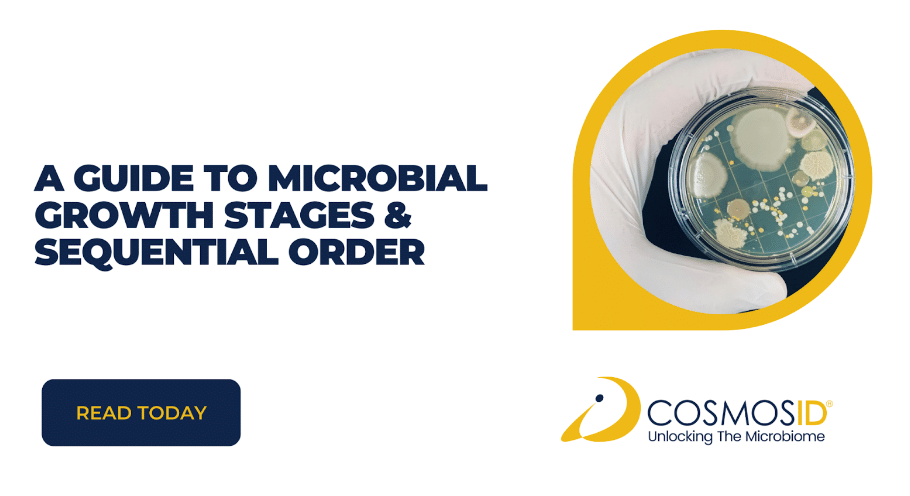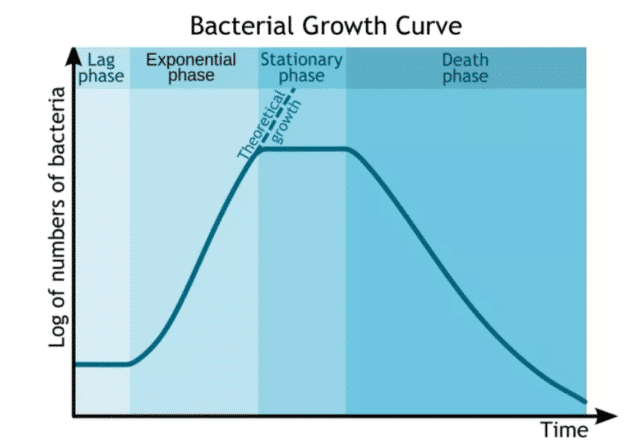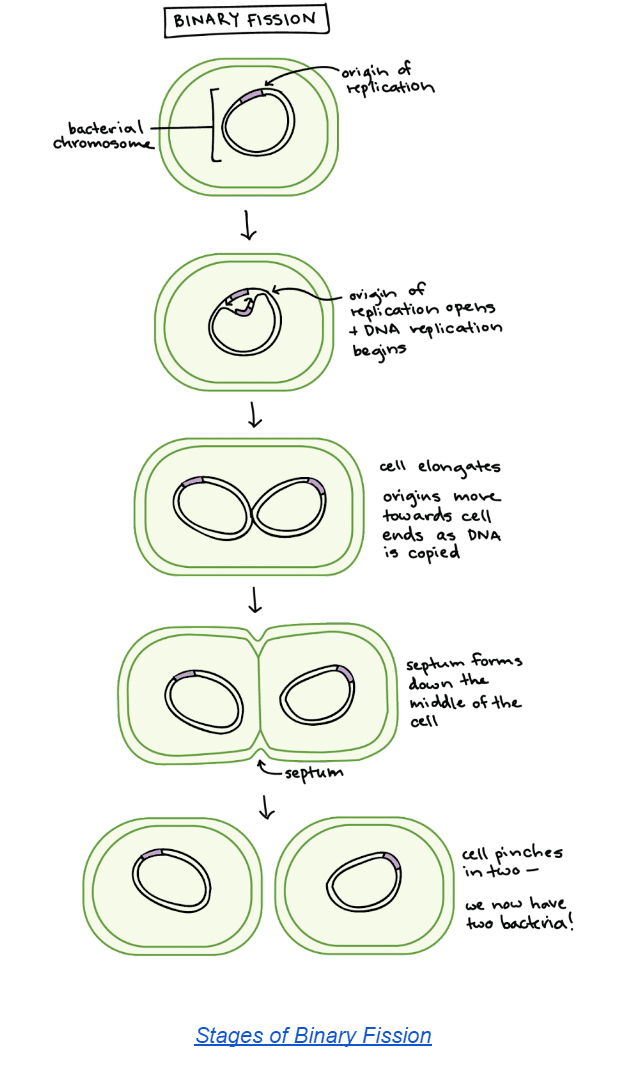Microbial growth is a dynamic and intricate process crucial for the survival and proliferation of bacterial cells. Understanding the sequential order of microbial growth stages is fundamental for researchers, microbiologists, and anyone delving into the fascinating realm of microbiology.
In this comprehensive guide, we will explore the four stages of microbial growth—lag, exponential (log), stationary, and death—while delving into the intricacies of the bacterial growth curve, the steps involved, and the underlying mechanisms governing microbial growth. Microbial growth is one of the fields of study that benefits from our microbiome sequencing service.
Microbial Growth: Briefly Explained
Before we dive into the specific stages of microbial growth, let’s establish a foundational understanding of what microbial growth entails.
Microbial growth refers to the increase in the number of bacterial cells, leading to the expansion of a bacterial population. This phenomenon is governed by a series of events collectively known as the bacterial growth cycle, where bacterial cells undergo various stages to achieve successful reproduction and proliferation.
Cell division, a fundamental aspect of bacterial life, is at the heart of microbial growth. Bacterial cells replicate through a process called binary fission, where one bacterial cell divides into two daughter cells. This rapid and efficient mode of reproduction allows bacterial populations to expand exponentially under favorable conditions.
Unlock the Power of the Microbiome now with CosmosID. Contact us today.
The Four Stages of the Microbial Growth in Sequential Order
The bacterial growth curve represents the number of living cells in a population over time. Michal Komorniczak/Wikimedia Commons/CC BY-SA 3.0
Understanding microbial growth means understanding the four stages and sequential order of the bacterial growth curve. This involves visualizing the progression of bacterial populations over time. Here are the key steps involved in the microbial growth curve:
Stage 1: Lag Phase
The first of the four distinct phases in the microbial growth curve is the lag phase. The lag phase begins with the introduction of bacterial cells into a new environment. During this phase, cells adjust to the surroundings, activate metabolic pathways, and prepare for active reproduction. The duration of the lag phase varies depending on the conditions of the environment and the health of the bacterial cells.
This initial stage is characterized by a period of slow growth or apparent stagnation. Despite external factors being conducive for growth, bacterial cells in this phase are busy preparing for active reproduction. During the lag phase, cells undergo various metabolic activities, synthesize essential molecules, and adapt to the new environment.
Key factors influencing the duration of the lag phase include the nutritional status of the environment, the health of the bacterial cells, and the availability of growth factors. Once the preparatory activities are complete, the microbial population transitions to the next stage, marking the beginning of exponential growth.
Stage 2: Exponential (Log) Phase
As the lag phase concludes, bacterial cells enter the exponential phase. This stage is marked by intense cell division, resulting in a rapid increase in the number of daughter cells. The exponential growth phase is a critical period where the bacterial population reaches its maximum growth rate.
The exponential phase, also known as the log phase, is characterized by rapid and unrestricted growth. At this stage, bacterial cells are actively dividing through binary fission, resulting in a doubling of the population with each generation. The exponential growth is often represented as a straight upward line on a graph, emphasizing the remarkable rate at which the bacterial population is expanding.
The factors influencing the exponential phase include the availability of nutrients, environmental conditions, and the absence of inhibitory factors. This stage continues until the bacterial population exhausts essential resources or faces unfavorable conditions, triggering the next phase in the microbial growth curve.
Stage 3: Stationary Phase
Following the exponential phase, the microbial population enters the stationary phase. The transition to the stationary phase occurs as resources become limited, and the bacterial population reaches a plateau.
During this stage, the rate of cell division equals the rate of cell death, leading to a stable population size. Bacterial cells in the stationary phase exhibit resilience to adverse conditions, enhancing their chances of survival.
This stage is characterized by a balance between cell division and cell death, resulting in a stabilization of the population size. The stationary phase is a consequence of limited resources, accumulation of metabolic by-products, and the activation of regulatory mechanisms that control bacterial growth.
During this phase, the rate of cell division equals the rate of cell death, leading to a plateau in the growth curve. Bacterial cells in the stationary phase exhibit enhanced stress resistance mechanisms, allowing them to survive adverse conditions. The stationary phase is a critical period in microbial growth, as it sets the stage for the subsequent decline in population size.
Stage 4: Death Phase
The death phase marks the final stage of the microbial growth curve. The death phase follows the stationary phase, characterized by a decline in the bacterial population. Factors such as nutrient depletion, the accumulation of toxic by-products, and environmental stress contribute to the decline in cell numbers. Some bacteria may enter a dormant state or form spores to endure harsh conditions during this phase.
In this phase, the population experiences a decline due to an imbalance between cell death and cell division. Resources become depleted, and the accumulation of waste products becomes toxic for bacterial cells. Factors such as nutrient scarcity, pH changes, and the presence of inhibitory substances contribute to the decline in population size.
While the death phase represents the end of the growth curve, it is important to note that some bacterial cells may enter a state of dormancy or form spores to withstand harsh conditions. These survival strategies allow certain bacteria to persist in the environment until conditions become favorable for growth once again.
Unlock the Power of the Microbiome now with CosmosID. Call us today.
Mechanisms Governing Microbial Growth
Binary Fission
The primary mechanism driving bacterial cell division is binary fission. In this process, a single bacterial cell divides into two daughter cells, each genetically identical to the parent cell. The steps involved in binary fission include DNA replication, elongation of the cell, and septum formation, ultimately leading to the formation of two distinct daughter cells.
Growth Factors
Microbial growth is heavily reliant on the availability of growth factors—essential nutrients required for cell metabolism and reproduction. These include carbon sources, nitrogen compounds, vitamins, and minerals. The presence or absence of growth factors directly influences the rate and success of microbial growth.
Environmental Conditions
The environmental conditions play a pivotal role in how microbes grow. Factors such as temperature, pH, oxygen levels, and osmotic pressure impact the growth rate and viability of bacterial cells. Each bacterial species has specific environmental preferences, and variations in these conditions can either facilitate or hinder microbial growth.
Conclusion
In summary, the journey of microbial growth is a fascinating exploration of biological intricacies. The four stages of the microbial growth curve—lag, exponential, stationary, and death—illustrate the dynamic nature of bacterial populations in response to their environment. The steps involved in the microbial growth curve highlight the transitions from preparatory phases to active growth, equilibrium, and eventual decline.
Understanding the mechanisms governing microbial growth, such as binary fission, the role of growth factors, and the impact of environmental conditions, provides a comprehensive view of this essential biological process.
As we delve deeper into the microscopic world of bacterial cells, the intricate dance of microbial growth stages unfolds, revealing the remarkable adaptability and resilience of these microscopic organisms in their quest for survival and proliferation.
Unlock the Power of the Microbiome now with CosmosID. Reach out to our consultants.
Microbial Growth Stages: FAQs
What are the 4 phases of the microbial growth curve?
The microbial growth curve comprises four phases: lag, exponential (log), stationary, and death. These phases describe the different stages of growth that microbial populations go through in a closed environment.
What is the growth curve in microbial growth?
The growth curve in microbial growth illustrates the changing population size over time, showcasing the phases of lag, exponential growth, stationary equilibrium, and decline.
What is the death phase of the growth curve?
The death phase of the growth curve is the decline phase, characterized by a reduction in the number of cells due to factors like nutrient depletion or environmental stress.
What is the lag phase of the microbial growth curve?
The lag phase is the initial phase of the microbial growth curve, where bacterial cells prepare for active reproduction without a significant increase in cell density. It’s a period of adaptation to optimal growth conditions before entering the exponential phase.
Want more like this? Sign-up to our newsletter to get the latest news from CosmosID:





